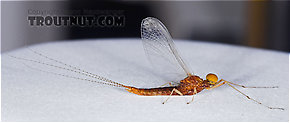Blog & Latest Updates
Fly Fishing Articles
Insects by Common Name


> > Thoughts
The Specimen
The Discussion
| Taxon | July 10th, 2006, 4:09 pm | |
Site Editor Royse City, TXPosts: 1350 | Jason- Your identification appears spot on. You may well have already considered them, but here are three key matches: 1} Genitalia illustrated in Leonard & Leonard p. 125 figure 75, which seems to match the claspers perfectly, and would likely match the penes perfectly as well, were they not a bit damaged 2) Sternites "with four small dots sometimes elongaged into narrow streaks" as described in Leonard & Leonard p. 50 3) "stigmatic area of fore wing milky" as described in Leonard & Leonard p. 50 | |
| Best regards, Roger Rohrbeck www.FlyfishingEntomology.com | ||
| Troutnut | July 10th, 2006, 8:39 pm | |
Administrator Bellevue, WAPosts: 2737 | Thanks for double-checking me. It's that much more convincing, now, because I arrived at needhami by different means. I used the keys from Allen & Edmunds' revision of the Ephemerellidae, though they can be a bit difficult to follow. | |
| Jason Neuswanger, Ph.D. Troutnut and salmonid ecologist | ||
| GONZO | October 14th, 2008, 9:12 pm | |
Site Editor "Bear Swamp," PAPosts: 1681 | I believe that this specimen is Eurylophella. In fact, except for the male dun identified by David Funk (#773), all of the duns and spinners (#549, #597, #546, #548, #598) in the E. needhami section appear to be Eurylophella. There also seems to be a male Eurylophella spinner (#544) in the E. invaria section, and a female Eurylophella spinner (#600) that has not been identified. Although some shots of the "naughty bits" of this specimen show damage or extraneous clutter, the first shot is clear and represents Eurylophella genitalia as depicted in McDunnough's 1931 review of the "bicolor" group--broad at the base, tapering apically, with a slight excision at the apex. The claspers of E. needhami are quite similar to Eurylophella, but the shape of the penes are very different. (McDunnough's original 1925 description has an illustration of the elongate tips of needhami.) The characteristic Eurylophella genitalia can also be seen in #549 and the specimen (#544) in the invaria section. Compare the genitalia of #544 (Eurylophella) to #545 (E. invaria). The latter has the bulge at the tip of the second segment of the clasper and the penes shape that is attributable to invaria. In addition to Dr. Funk's comments (in the thread associated with #773) about Eurylophella subs having blackish wings and orange eyes (males), these traits are also worth noting: 1. Bodies are usually brown (ranging from dark to orangish or yellowish brown), and legs are pale yellowish, often with a dark spot or spots on the coxae and sometimes on the trochanters. 2. Abdomen is somewhat slender with a long 9th segment. (This feature is mentioned in most keys to the nymphs, but not the adults. I think it is one of the easiest ways to recognize this genus.) 3. Although variable, many have a dorsal pattern of longitudinal stripes. 4. Many species have a ventral pattern of (often 4) spots and/or lateral slashes. 5. Tails usually have dark marks at segments. | |
| Trtklr | October 17th, 2008, 9:10 am | |
Banned MichiganPosts: 115 | why don't i see people tying the front legs of insects onto their flies? I try to set a few hairs forward when I tye off hackle and trim as needed, because it seems to me that there is almost always something coming off the front of an insect whether it be legs or antenna. | |
| I have seen nothing more beautiful than the sunrise on a cold stream. | ||
| Sayfu | March 7th, 2013, 6:12 pm | |
| Posts: 560 | Probably because it gets hard enough for old dudes like myself to insert a fine tippet in a small eyed hook without having the complications of material tied forward in front of the eye. | |
| Entoman | March 7th, 2013, 6:24 pm | |
| Northern CA & ID Posts: 2604 | That's right, Jere. It is unnecessary to purposely imitate front legs as some of the hackles do this perfectly after tying on.:) | |
| "It's not that I find fishing so important, it's just that I find all other endeavors of Man equally unimportant... And not nearly as much fun!" Robert Traver, Anatomy of a Fisherman | ||
Quick Reply
You have to be logged in to post on the forum. It's this easy:
Related Discussions
Troutnut.com is copyright © 2004-2024 Jason
Neuswanger (email Jason). See my FAQ for information about use of my images.
 privacy policy
privacy policy




